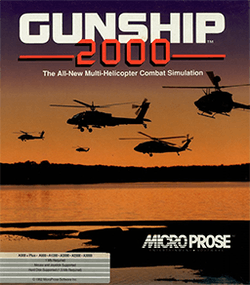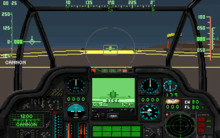Gunship 2000
| Gunship 2000 | |
|---|---|
 | |
| Developer(s) | MicroProse |
| Publisher(s) | MicroProse |
| Designer(s) |
James M. Day Darrell Dennies Detmar Peterke |
| Programmer(s) |
Darrell Dennies Detmar Peterke |
| Artist(s) |
Michael Reis Max D. Remington III Michael Gibson |
| Composer(s) |
Jeffery L. Briggs Ken Lagace Jim McConkey |
| Platform(s) | Amiga, Amiga CD32, DOS, PlayStation |
| Release date(s) | 1991-1996 |
| Genre(s) | Combat flight simulator |
| Mode(s) | Single player |
Gunship 2000 is a helicopter combat flight simulator and is the sequel to Gunship by MicroProse. It was released in 1991 for DOS. Amiga, Amiga CD32 and PlayStation versions were released in 1993, 1994 and 1996 respectively. The PlayStation version was retitled as simply Gunship, but was sometimes[1] still referred to as Gunship 2000.
Gunship 2000 significantly enhanced and expanded the features and gameplay from the original Gunship. Key areas of change were a move to full 256-color graphics, enhanced terrain and general visuals, the ability to fly multiple helicopter types and finally the ability to command a team of helicopters and their crews.
Gameplay

Gunship 2000 utilised roughly the same format as most of the other MicroProse flight simulators of the time. That is, the player had a profile, chose their combat theatre, and either performed single missions or a campaign. The primary similarity was the randomly generated 'primary-secondary' mission types where the player was given a primary mission (destroy a target / pickup or drop off troops or cargo / recon an objective) and a less valuable secondary objective that included the same kind of tasks as a primary. The campaign strung these missions together in a 'tug-of-war' system. Victories advanced the player's side towards victory and harder missions, defeat went the other way (though the missions sometimes got harder too).
Initially the player flew a lone helicopter to complete missions, choosing between AH-1 Cobra, AH-64 Apache, OH-58D Kiowa Warrior, MD 530MG and UH-60 Blackhawk. As the player's rank increased, the RAH-66 Comanche and the AH-64B Apache Longbow were unlocked (the 'B' designation is due to the game being designed before the Longbow Apache was in service as the 'D' model). Another interesting side note is that the RAH-66 Comanche was included in the game as it was in development for the U.S. Army at the time, however the Comanche never made it beyond its prototype stage and into service. Using less powerful helicopters resulted in a higher mission score, though this had to be balanced with the likelihood of having enough fuel/weapons to complete the mission.
Given the computing technology of the time and the survey simulation nature of the game (covering multiple helicopters), Gunship 2000 was never going to be a totally realistic simulation. However, the cockpits were reasonable copies of the real helicopter cockpits, and certain features such as Mast Mounted Sights were present on the smaller scout helicopters. However, avionics and flight modelling was rather generic. Realistic tactics such as nap-of-the-earth flight and 'pop-up' attacks could be employed on account of the reasonably detailed terrain.
Planning is often an important part of the game: fuel consumption was unrealistically high (which was a good thing in this context), and the player can rarely lift off with full fuel and the best weapons loaded. Terrain and enemy presence are also to be considered (the intel briefing may often tell the player what to expect near targets). Usually a Forward Arming Refuel Point (FARP) is present in the mission. This is important, as the player may have to refuel or rearm during the course of the mission depending on the density of enemy and distance to objectives.
On promotion to the rank of 2nd Lieutenant, the player may gain control of several other helicopter wingmen whose helicopters can also be configured to the same extent as the players. Wingmen can remain with the player or be sent off for separate tasks (such as completing the secondary objective), so a great deal of flexibility is present for tactical planning.
The visuals of the game are significantly better than those of Gunship. For the time the terrain modelling was quite good, with desert wadis and twisting ridgelines being well represented. This was very important for simulating helicopter combat, as cover using terrain is one of the primary tactics. The game had two primary theatres: the Middle East and Europe. Terrain was designed separately for each theatre; for instance, desert really was desert, and not just European farmland painted brown. Visuals in other areas were about on par for the private flight simulator technology at the time (the later PlayStation version of the game features much better graphics, including full textures on all 3D objects). The helicopter models were identifiable but were not highly detailed. Land vehicles and structures were of mixed quality, with some being a few rectangles and a window, and others sprouting roof mounted machine guns and antennas. Importantly, vehicles could be told apart by shape and features. Enemies included towed guns, BMP-1, infantry, SAM, Mi-24 Hind, SA-13, BRDM-2, E-9, T72, ZSU-23, Gazelle, MIG's and more. Other game objects included moving railroad vehicles, civilian buildings, billboards and even animals. The 2D menus and screens in the game were of high quality, especially the arming screen for the helicopters, which allowed the user to see exactly what weapons were being loaded on the helicopter of choice.
Gunship 2000: Islands and Ice
MicroProse released the Gunship 2000: Islands & Ice expansion pack in 1992. It added two theatres of war (Antarctica and The Philippines), all previously released patches, and a mission editor.[2]
Gameplay followed closely on the heels of Gunship 2000, but added unique aspects for the two new theaters as well as a number of additional functions and new player aids, including: in-flight mission changes, air and artillery support, wind and weather (including whiteouts and magnetic disturbances in Antarctica), maintenance and weapon system downtimes, improved autopilot, targeting, navigation, and the addition of a HUD mission clock.
One of the most innovative features was the mission builder. This tool enabled players to create and edit missions of their own design. Every aspect of a typical Gunship 2000 mission was available for use in the mission builder. It also provided a number of shortcut steps to enable players to quickly create new missions without having to, for example, place every defender on the map one-by-one. Players could even export a standard Gunship 2000 mission into the mission builder as a template for editing. Once completed, mission could be saved for play, editing or free exchange with other players. Very advanced for its day, the mission builder set the tone for many follow on products by enabling players to determine fun by their own standards.
Reception
In 1991 Computer Gaming World's reviewer, a United States Army AH-64 pilot, criticized Gunship 2000 for presenting a helicopter that "flies like an overloaded Huey", but nonetheless concluded that "the designers have succeeded in creating the best helicopter simulator game currently available, thorns included". Cited flaws included inaccurate flight models and avionics; awkward controls; and mediocre graphics and lack of ground texture. Strengths included a wide variety of accurately modeled weapons and the ability to control multiple types of helicopters in a squadron.[3] In 1993 the reviewer reported that the Islands and Ice expansion and patches provided an improved flight model, the option to fly with two joysticks and other peripherals, and target designation. He found that he could recreate missions from his career with the scenario editor with "surprising accuracy", and concluded that the expansion "has helped transform what was a mediocre title into a much better gaming value ... my vote as 'Most Improved Game of the Year'".[2]
A 1992 survey in Computer Gaming World of wargames with modern settings gave the game four stars out of five,[4] and the magazine named it one of the year's best simulation games.[5] The game received 5 out of 5 stars in Dragon.[6] PlayStation Magazine gave the PlayStation version a score of 7/10, calling it an "immersive helicopter flying sim with engrossing, varied missions."[1]
Legacy
MicroProse's GUNSHIP! was released in March 2000 and was not as successful, largely due to its unfinished state and the cancellation of M1 TANK PLATOON!, which it was supposed to integrate with. All three of these helicopter titles share some common features pioneered in Gunship 2000, especially the crew management and in some cases, mission structure.
Jane's Longbow and Jane's Longbow 2 were considered spiritual successors to Gunship 2000.
References
- 1 2 PSM 8
- 1 2 Walker, Bryan A. (January 1993). "Locking On To MicroProse's Gunship 2000 Scenario Disk". Computer Gaming World. p. 162. Retrieved 5 July 2014.
- ↑ Walker, Bryan A. (December 1991). "Flaming Arrows of the "Apache"". Computer Gaming World. p. 34. Retrieved 18 November 2013.
- ↑ Brooks, M. Evan (June 1992). "The Modern Games: 1950 - 2000". Computer Gaming World. p. 120. Retrieved 24 November 2013.
- ↑ "CGW Salutes The Games of the Year". Computer Gaming World. November 1992. p. 110. Retrieved 4 July 2014.
- ↑ Lesser, Hartley; Lesser, Patricia & Lesser, Kirk (February 1992). "The Role of Computers". Dragon (178): 57–64.
External links
- Gunship 2000 at MobyGames
- Gunship 2000 can be played for free in the browser at the Internet Archive